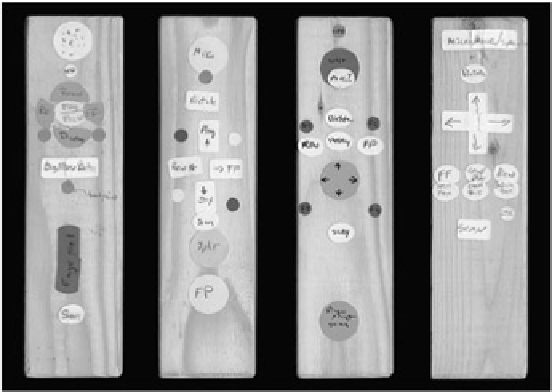Database Reference
In-Depth Information
Collaborative Design: Wood Blocks and Stickers
Bob and I wanted to show the development team our drawings, but first I wanted to have a group
design session. Successful design is a collaborative effort—they bring us consultants in for our design
knowledge, but the team members have the domain knowledge. An activity where people make
something concrete is a great way to transfer that knowledge. A design exercise forces people to be
explicit about their ideas, so you get better and richer information than when they just talk. We decided
to do this exercise before showing them our drawings so that our ideas wouldn't influence them.
So we had them build microphone models. Bob prepared blocks of wood that were about the size of
the microphone. We gave the team members pens and blank stickers in various sizes. We began the
session with a discussion of the features they wanted on the device, just to get ideas going. As always,
there was some skepticism—people are always a little leery when they have to do something that
reminds them of art class! But once we got started, everyone really got involved. Some samples are
shown in
Figure 15.3
.
Figure 15.3:
Using wood blocks and stickers, the team members experimented with button layouts
and discussed their ideas. This exercise led to several changes in the assumptions about the
design.
At the end of the meeting, Bob and I showed them our schematics. Turns out that some of our
drawings weren't valid any longer because our brainstorming discussion had simplified the design by
moving some features from the microphone to the base it would sit in. So this exercise was very
successful. It was hard work for them to turn their ideas into something tangible, but they realized that
we had discussed the design in far more detail than before.
I think it's important to accept design advice from my clients because they've thought about the problem
longer than I have. Team members had great ideas about arranging controls that helped Bob and me in
our next round of design. Bob and I walked away with four complete prototype designs to use in our
subsequent design work. It doesn't matter that we didn't develop all of the ideas—our job is to come up
with a good design that makes the product successful.
Fome-Cor Mockups
We were concerned about the possibility of hand fatigue if users used the microphone for long
stretches of time. The design schedule called for making full 3D foam models at this point, but they're
expensive and take a week or two to make. We wanted some quicker feedback first. We had a pretty
good idea of the relative importance of the buttons, and realized that it'd be okay for users to reach a
little for the less-used ones. Our goal at this stage was to identify problems due to button location.
Where would the user's hand rest? How hard would it be to reach the various buttons? Would it be
okay to adjust one's grip to reach some buttons?
Bob made models of some button layouts using Fome-Cor (polystyrene foam sandwiched between two
pieces of paper, available in various thicknesses). He drew the button layouts on Fome-Cor and cut
them out to fit over the lower half of an existing microphone shell. Bob created about eight of these,









Search WWH ::

Custom Search